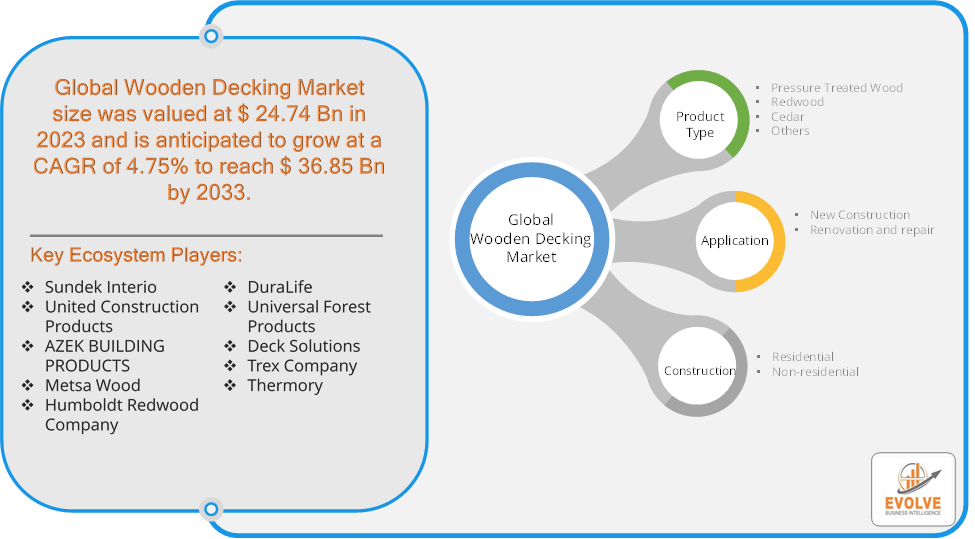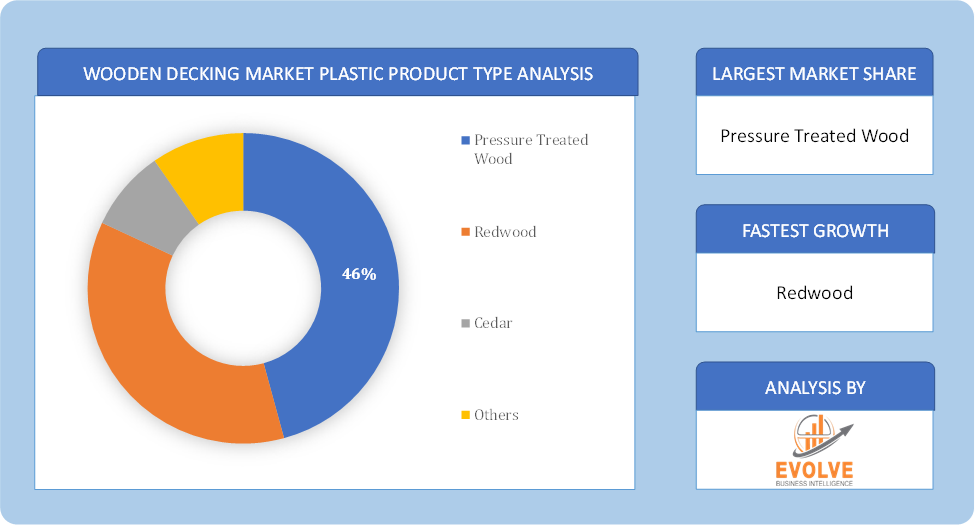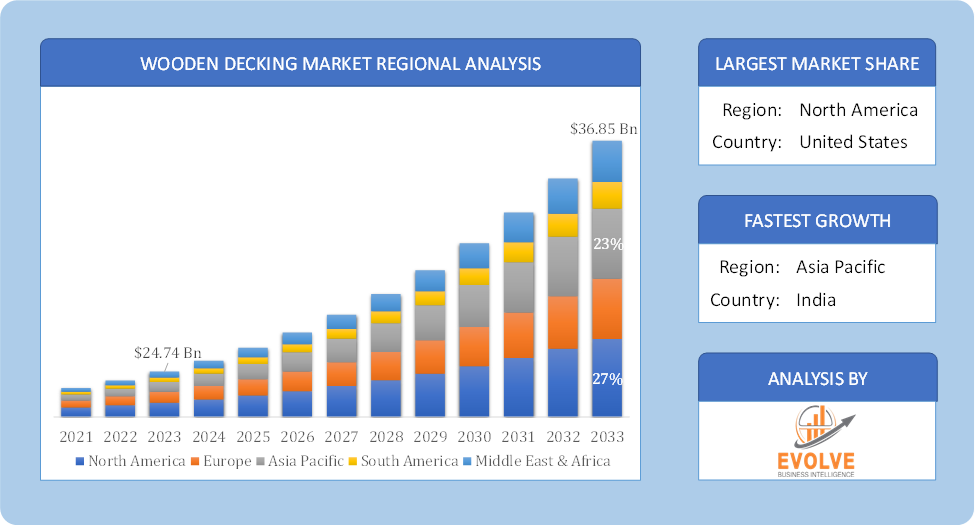Wooden Decking Market Overview
The Wooden Decking Market Size is expected to reach USD 36.85 Billion by 2033. The Wooden Decking industry size accounted for USD 24.74 Billion in 2023 and is expected to expand at a compound annual growth rate (CAGR) of 4.75% from 2023 to 2033. Wooden decking refers to a construction material used to build outdoor living spaces such as patios, balconies, and decks. It is made of various types of wood species, including cedar, redwood, pressure-treated pine, and tropical hardwoods such as ipe and mahogany. Wooden decking boards are available in a range of sizes, textures, and finishes, and can be customized to fit the specific design and aesthetic preferences of the homeowner or builder. Wooden decking is valued for its durability, natural appearance, and ability to withstand outdoor weather conditions.
Global Wooden Decking Market Synopsis
 COVID-19 Impact Analysis
COVID-19 Impact Analysis
During the early stages of the pandemic, the wooden decking market experienced disruptions in the supply chain due to lockdowns and restrictions on international trade. Many sawmills and wood processing facilities had to shut down temporarily, causing delays in the production and delivery of wooden decking products. However, as the pandemic continued, there was a surge in demand for wooden decking as more people stayed home and invested in their outdoor living spaces. With international travel restrictions and limits on social gatherings, homeowners turned to outdoor living spaces such as decks and patios as a way to expand their living areas and enjoy the fresh air.
Global Wooden Decking Market Dynamics
The major factors that have impacted the growth of Wooden Decking are as follows:
Drivers:
⮚ The growth of the construction industry
The construction industry’s growth, particularly in the residential sector, directly impacts the demand for wooden decking products. As the construction industry grows, there is an increasing demand for new residential and commercial buildings, which often include outdoor living spaces such as decks, patios, and balconies. Wooden decking is a popular choice for these outdoor living spaces due to its durability, natural beauty, and versatility in design. Moreover, as the global population continues to grow, the demand for new homes and residential properties is also increasing. This trend is particularly prominent in emerging economies, where rising incomes and urbanization are leading to a growing middle class and an increasing demand for new housing. As a result, the demand for Wooden Decking is expected to continue growing in the future.
Restraint:
- The increasing cost of lumber and wood products
the cost of lumber and wood products has increased significantly due to a variety of factors, including supply chain disruptions, increased demand, and trade disputes. The COVID-19 pandemic has also had a significant impact on the lumber industry, leading to a shortage of lumber and driving up prices. As a result of the increasing cost of lumber, wooden decking products have become more expensive, making them less attractive to budget-conscious consumers.
Opportunity:
⮚ Technological advancements in wooden decking
There have been significant advancements in wooden decking technology, particularly in terms of treatment methods to enhance durability and resistance to decay and insects. The use of pressure-treated lumber has become increasingly common in wooden decking, which involves treating the wood with chemicals to make it more durable and resistant to rot, decay, and insects. Moreover, there have been innovations in the design and installation of wooden decking products.
Wooden Decking Market Segment Overview
 By Product Type
By Product Type
Based on the Type, the Wooden Decking market is segmented based on Pressure Treated Wood, Redwood, Cedar, and Others. During the projection period, the Redwood segment is expected to hold the largest market share. Redwood is a popular type of wood used for decking due to its natural resistance to rot and decay, as its attractive reddish-brown color. It is also relatively easy to work with and has good dimensional stability, making it a popular choice for decking projects.
By Application
Based on Application, the global Wooden Decking market has been divided into New Construction, Renovation, and repair. The New Construction segment is expected to hold the largest market share. This segment is expected to hold a significant share of the market due to the growing demand for new construction projects in many regions around the world.
By Construction
Based on Construction, the market has been divided into Non-residential. The Non-residential segment is expected to hold the largest market share. The Non-residential segment of the Wooden Decking Market typically includes commercial and public infrastructure projects such as hotels, resorts, theme parks, and public parks. This segment is expected to hold a significant share of the market due to the growing demand for outdoor spaces in commercial and public settings.
Global Wooden Decking Market Regional Analysis
Based on region, the market has been divided into North America, Europe, Asia-Pacific, the Middle East & Africa, and Latin America. The area of North America is anticipated to dominate the market for the usage of Wooden Decking, followed by those in Asia-Pacific and Europe.
 Wooden Decking North America Market
Wooden Decking North America Market
North America is a significant market for wooden decking and has historically been one of the largest markets for this product. The demand for wooden decking in North America can be attributed to several factors, including the popularity of outdoor living spaces and the widespread use of wood as a construction material in the region. In addition, the climate in many parts of North America is well-suited for outdoor activities, which has further increased demand for decking materials. However, it is important to note that the wooden decking market is global, and the relative dominance of any particular region can vary depending on a variety of factors such as economic growth, construction activity, and consumer preferences.
Wooden Decking Asia Pacific Market
Asia Pacific is expected to be a significant growth market for wooden decking in the coming years. The demand for wooden decking in the Asia Pacific can be attributed to several factors, including growing urbanization, rising disposable income, and increasing popularity of outdoor living spaces in the region. In addition, the construction industry in Asia Pacific is rapidly expanding, driven by factors such as population growth and infrastructure development, which are expected to drive demand for decking materials.
Competitive Landscape
The competitive landscape includes key players (tier 1, tier 2, and local) having a presence across the globe. Companies such as Sundek Interio, United Construction Products, AZEK BUILDING PRODUCTS, Metsa Wood, and Humboldt Redwood Company are some of the leading players in the global Wooden Decking Industry. These players have adopted partnership, acquisition, expansion, and new product development, among others as their key strategies.
Key Market Players:
- Sundek Interio
- United Construction Products
- AZEK BUILDING PRODUCTS
- Metsa Wood
- Humboldt Redwood Company
- DuraLife
- Universal Forest Products
- Deck Solutions
- Trex Company
- Thermory
Key development:
In September 2022, United Construction Products made a significant advancement in the wooden decking market by launching a new line of eco-friendly, high-durability decking products aimed at enhancing outdoor living spaces with sustainable materials.
Scope of the Report
Global Wooden Decking Market, by Product Type
- Pressure Treated Wood
- Redwood
- Cedar
- Others
Global Wooden Decking Market, by Application
- New Construction
- Renovation and repair
Global Wooden Decking Market, by Construction
- Residential
- Non-residential
Global Wooden Decking Market, by Region
- North America
- US
- Canada
- Mexico
- Europe
- UK
- Germany
- France
- Italy
- Spain
- Benelux
- Nordic
- Rest of Europe
- Asia Pacific
- China
- Japan
- South Korea
- Indonesia
- Austalia
- Malaysia
- India
- Rest of Asia Pacific
- South America
- Brazil
- Argentina
- Rest of South America
- Middle East & Africa
- Saudi Arabia
- UAE
- Egypt
- South Africa
- Rest of Middle East & Africa
| Parameters | Indicators |
|---|---|
| Market Size | 2033: USD 36.85Billion |
| CAGR (2023-2033) | 4.75% |
| Base year | 2022 |
| Forecast Period | 2023-2033 |
| Historical Data | 2021 (2017 to 2020 On Demand) |
| Report Coverage | Revenue Forecast, Competitive Landscape, Growth Factors, and Trends |
| Key Segmentations | Product Type, Application, Construction |
| Geographies Covered | North America, Europe, Asia-Pacific, South America, Middle East, Africa |
| Key Vendors | Sundek Interio, United Construction Products, AZEK BUILDING PRODUCTS, Metsa Wood, Humboldt Redwood Company, DuraLife, Universal Forest Products, Deck Solutions, Trex Company, Thermory. |
| Key Market Opportunities | · Technological advancements in wooden decking |
| Key Market Drivers | · The growth of the construction industry |
REPORT CONTENT BRIEF:
- High-level analysis of the current and future Wooden Decking Industry trends and opportunities
- Detailed analysis of current market drivers, restraining factors, and opportunities analysis in the future
- Historical market size for the year 2021, and forecast from 2023 to 2033
- Wooden Decking market share analysis for each segment
- Competitor analysis with a comprehensive insight into its product segment, financial strength, and strategies adopted.
- Identifies key strategies adopted by the key players including new product development, mergers and acquisitions, joint ventures, collaborations, and partnerships.
- To identify and understand the various factors involved in the global Wooden Decking market affected by the pandemic
- To provide year-on-year growth from 2022 to 2033
- To provide short-term, long-term, and overall CAGR comparison from 2022 to 2033.
- Provide Total Addressable Market (TAM) for the Global Wooden Decking Market.


 Wooden Decking North America Market
Wooden Decking North America Market


